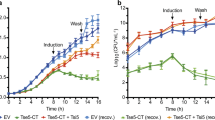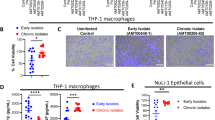Abstract
Pseudomonas aeruginosa infection is a serious complication in patients with cystic fibrosis and in immunocompromised individuals. Here we show that P. aeruginosa infection triggers activation of the acid sphingomyelinase and the release of ceramide in sphingolipid-rich rafts. Ceramide reorganizes these rafts into larger signaling platforms that are required to internalize P. aeruginosa, induce apoptosis and regulate the cytokine response in infected cells. Failure to generate ceramide-enriched membrane platforms in infected cells results in an unabated inflammatory response, massive release of interleukin (IL)-1 and septic death of mice. Our findings show that ceramide-enriched membrane platforms are central to the host defense against this potentially lethal pathogen.
This is a preview of subscription content, access via your institution
Access options
Subscribe to this journal
Receive 12 print issues and online access
$209.00 per year
only $17.42 per issue
Buy this article
- Purchase on Springer Link
- Instant access to full article PDF
Prices may be subject to local taxes which are calculated during checkout





Similar content being viewed by others
Change history
10 February 2003
This was incorrect in AOP version but corrected in print. Regplaced Figure 1 and Figure 3 as per note.
Notes
NOTE: In the version of this article initially published online, the labels for Figs. 1 and 3d were incorrect. The upper left label of Fig. 1a should read 'not infected'. All labels that read 'TEM' should read 'transmission'. This mistake has been corrected for the HTML and print versions of the article.
References
Vidal, F. et al. Epidemiology and outcome of Pseudomonas aeruginosa bacteremia, with special emphasis on the influence of antibiotic treatment. Analysis of 189 episodes. Arch. Intern. Med. 156, 2121–2126 (1996).
Crouch Brewer, S., Wunderink, R.G., Jones, C.B. & Leeper, K.V. Ventilator-associated pneumonia due to Pseudomonas aeruginosa. Chest 109, 1019–1029 (1996).
Pier, G.B. et al. Role of mutant CFTR in hypersensitivity of cystic fibrosis patients to lung infections. Science 271, 64–67 (1996).
Schroeder, T.H. et al. Transgenic cystic fibrosis mice exhibit reduced early clearance of Pseudomonas aeruginosa from the respiratory tract. J. Immunol. 166, 7410–7418 (2001).
Grassmé, H. et al. Host defense to Pseudomonas aeruginosa requires CD95/CD95 ligand interaction on epithelial cells. Science 290, 527–530 (2000).
Hauser, A.R. & Engel, J.N. Pseudomonas aeruginosa induces type-III-secretion-mediated apoptosis of macrophages and epithelial cells. Infect. Immun. 67, 5530–5537 (1999).
Rajan, S. et al. Pseudomonas aeruginosa induction of apoptosis in respiratory epithelial cells. Am. J. Respir. Cell. Mol. Biol. 23, 304–312 (2000).
Schultz, M.J. et al. Role of interleukin-1 in the pulmonary immune response during Pseudomonas aeruginosa pneumonia. Am. J. Physiol. Lung Cell. Mol. Physiol. 282, L285–L290 (2002).
Xue, M.L. et al. The role of IL-1β in the regulation of IL-8 and IL-6 in human corneal epithelial cells during Pseudomonas aeruginosa colonization. Curr. Eye Res. 23, 406–414 (2001).
Inoue, H. et al. Pseudomonas stimulates interleukin-8 mRNA expression selectively in airway epithelium, in gland ducts, and in recruited neutrophils. Am. J. Resp. Cell. Mol. Biol. 11, 651–663 (1994).
Harder, T. & Simons, K. Caveolae, DIGs, and the dynamics of sphingolipid-cholesterol microdomains. Curr. Opin. Cell Biol. 9, 534–542 (1997).
Brown, D.A. & London, E. Structure and origin of ordered lipid domains in biological membranes. J. Membr. Biol. 164, 103–114 (1998).
Grassmé, H. et al. CD95 signaling via ceramide rich membrane rafts. J. Biol. Chem. 276, 20589–20596 (2001).
Cremesti, A. et al. Ceramide enables Fas to cap and kill. J. Biol. Chem. 276, 23954–23961 (2001).
Liu, P. & Anderson, R.G.W. Compartmentalized production of ceramide at the cell surface. J. Biol. Chem. 270, 27179–27185 (1995).
Schutze, S. et al. TNF activates NFκB by phosphatidylcholine-specific phospholipase C-induced “acidic” sphingomyelin breakdown. Cell 71, 765–767 (1992).
Veiga, M.P., Arrondo, J.L., Goni, F.M. & Alonso, A. Ceramides in phospholipid membranes: effects on bilayer stability and transition to nonlammelar phases. Biophys. J. 76, 342–350 (1999).
Holopainen, J.M., Subramanian, M. & Kinnunen, P.K. Sphingomyelinase induces lipid microdomain formation in a fluid phosphatidylcholine/sphingomyelin membrane. Biochemistry 37, 17562–17570 (1998).
Jendrossek, V. et al. P. aeruginosa induced apoptosis involves mitochondria and stress activated protein kinases. Infect. Immun. 69, 2675–2683 (2001).
Voll, R.E., Herrmann, M., Roth, E.A, Stach, C. & Kalden, J.R. Immunosuppressive effects of apoptotic cells. Nature 390, 350–351 (1997).
Fadok, V.A. et al. A receptor for phosphatidylserine-specific clearance of apoptotic cells. Nature 405, 85–90 (2000).
Savill, J. & Fadok, V. Corpse clearance defines the meaning of cell death. Nature 407, 784–788 (2000).
Shin, J.S., Gao, Z. & Abraham, S.N. Involvement of cellular caveolae in bacterial entry into mast cells. Science 289, 732–733 (2000).
Gatfield, J. & Pieters, J. Essential role for cholesterol in entry of mycobacteria into macrophages. Science 288, 1647–1650 (2000).
Wooldrige, K.G., Williams, P.H. & Ketley, J.M. Host signal transduction and endocytosis of Campylobacter jejuni. Microb. Pathog. 21, 299–305 (1996).
Anderson, H.A., Chen, Y. & Norkin, L.C. Bound simian virus 40 translocates to caveolin-enriched membrane domains, and its entry is inhibited by drugs that selectively disrupt caveolae. Mol. Biol. Cell 7, 1825–1834 (1996).
Manie, S.N., Debreyne, S., Vincent, S. & Gerlier, D. Measles virus structural components are enriched into lipid raft microdomains: a potential cellular location for virus assembly. J. Virol. 74, 305–311 (2000).
Jan, J.T., Chatterjee, S. & Griffin, D.E. Sindbis virus entry into cells triggers apoptosis by activating sphingomyelinase, leading to the release of ceramide. J. Virol. 74, 6425–6432 (2000).
Scheiffele, P., Rietveld, A., Wilk, T. & Simons, K. Influenza viruses select ordered lipid domains during budding from the plasma membrane. J. Biol. Chem. 274, 2038–2044 (1999).
Olliaro, P. & Castelli, F. Plasmodium falciparum: an electron microscopy study of caveolae and trafficking between the parasite and the extracellular medium. Int. J. Parasitol. 27, 1007–1012 (1997).
Kaneko, K. et al. COOH-terminal sequence on the cellular prion protein directs subcellular trafficking and controls conversion into the scrapie isoform. Proc. Natl. Acad. Sci. USA 94, 2333–2338 (1997).
Kolesnick, R.N. 1,2-Diacylycerols, but not phorbol esters, stimulate sphingomyelin hydrolysis in GH3 pituitary cells. J. Biol. Chem. 262, 16759–167621 (1987).
Kolesnick, R.N. & Clegg, S. 1,2-Diacylycerols, but not phorbol esters, activate a potential inhibitory pathway for protein kinase C in GH3 pituitary cells. Evidence for involvement of a sphingomyelinase. J. Biol. Chem. 263, 6534–6537 (1988).
Grassmé, H. et al. Acidic sphingomyelinase mediates internalization of Neisseria gonorrhoeae into non-phagocytic cells. Cell 91, 605–615 (1997).
Esen, M. et al. Invasion of human epithelial cells by Pseudomonas aeruginosa involves Src-like tyrosine kinases p60Src and p59Fyn. Infect. Immun. 69, 281–287 (2001).
Gulbins, E. et al. Fas induced apoptosis is mediated by a ceramide initiated Ras signaling pathway. Immunity 2, 341–351 (1995).
Kirschnek, S. et al. CD95-mediated apoptosis in vivo involves acid sphingo-myelinase. J. Biol. Chem. 275, 27316–27323 (2000).
Acknowledgements
E.G. was supported in part by the Deutsche Forschungsgemeinschaft (Gu 335/10-2 and Mo 435/17-1); the European Union; the Association for International Cancer Research; the National Cancer Institute (CA21765); and American Lebanese Syrian Associated Charities. M.W. was supported by the Deutsche Forschungsgemeinschaft (We 1502/10-1). R.K. was supported by the National Cancer Institute (CA85704).
Author information
Authors and Affiliations
Corresponding author
Ethics declarations
Competing interests
The authors declare no competing financial interests.
Supplementary information
Rights and permissions
About this article
Cite this article
Grassmé, H., Jendrossek, V., Riehle, A. et al. Host defense against Pseudomonas aeruginosa requires ceramide-rich membrane rafts. Nat Med 9, 322–330 (2003). https://doi.org/10.1038/nm823
Received:
Accepted:
Published:
Issue Date:
DOI: https://doi.org/10.1038/nm823
This article is cited by
-
LiLA: lipid lung-based ATLAS built through a comprehensive workflow designed for an accurate lipid annotation
Communications Biology (2024)
-
The bacterial lectin LecA from P. aeruginosa alters membrane organization by dispersing ordered domains
Communications Physics (2023)
-
Acid sphingomyelinase expression is associated with survival in resectable pancreatic ductal adenocarcinoma
Journal of Molecular Medicine (2023)
-
The relevance of acid sphingomyelinase as a potential target for therapeutic intervention in hepatic disorders: current scenario and anticipated trends
Archives of Toxicology (2023)
-
Acid sphingomyelinase/ceramide system in schizophrenia: implications for therapeutic intervention as a potential novel target
Translational Psychiatry (2022)



